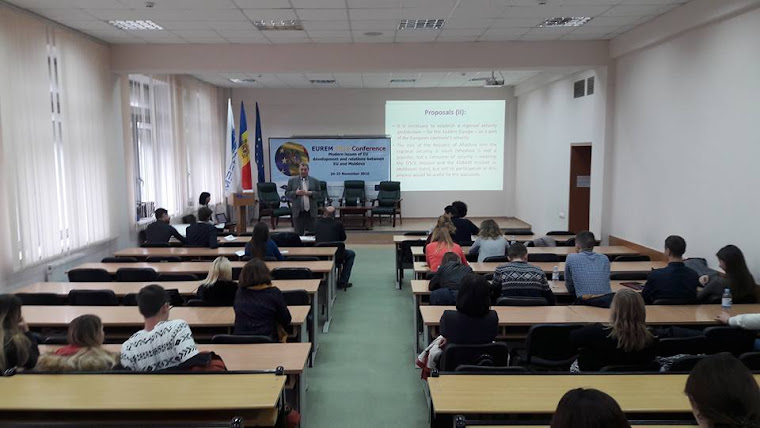The
origin of the Transnistrian conflict, which turned into a war in 1992, is
within the border marked in 1940, as a result of which the Southern and Northern
Bessarabia (also Hertsa district, and North Bukovina Moldovan-Romanian villages
from the districts Storojinets and Adâncata – that for centuries belonged to the Principality of Moldova)
were granted by the leadership from Moscow to Ukraine, and Moldova in
return was given a strip on the left bank of the Dniester river. It is
true that on the territory, across the Dniester, have been and are more
villages inhabited by Moldovans, but after the exchange of territories, in
composition of the SSMR entered also localities inhabited by Ukrainian
population, as beyond the Moldovan – Ukrainian border, on the left bank of
Dniester, remained Moldovan villages: Handrabura, Dolinskoe
(Valea Hotsului), Tocileva etc. in Odesa region. A correction of borders
at this stage, between Ukraine and the Republic of Moldova, after which
most of the localities populated by Moldovans over the Dniester (the
so-called Nistrian Moldovan Republic) would return under the jurisdiction
of Chisinau, and those inhabited by Ukrainians, as well as the localities
where ethnic Russians are numerous, but which are oriented (geographically and
economically turned) mostly to Odessa (as the town of Tiraspol) would be
returned to Ukraine, and in exchange of this territory, Ukraine would
return the area with exactly the same size of land with localities inhabited
by population identifying themselves as Moldovans (the districts Noua
Suliţă, Reni) or Romanians (districts of Herţa, Adâncata and Storojinets)
would be a sustainable solution. Following the implementation of this idea,
there would disappear the state of uncertainty and tension of the Gagauz
autonomy, whose leaders have declared repeatedly that they expect the
federalization of the RM and acceptance of the autonomous territorial unit
as an entity in the new Moldovan state formula.
There
are several precedents in the history of international law, which allow us to
say that this scenario is feasible. Besides the recent exchange (1999) of
territories between the RM and Ukraine (Giurgiulești
– Palanca), there are cases known after the World War I, when Romania exchanged territories with Czechoslovakia (in the Maramuresh region) and
with the Kingdom of Serbs , Croats and Slovenes (in the Banat region).
Regarding
the establishment of the Romanian-Czechoslovak border, “on April 1, 1920
by approaches sent to the Ministry of Foreign Affairs and to the Ministry
of War, Czechoslovakia's representative in Romania renewed on behalf of
the government the request for evacuation of Romanian troops from the northern
territory of the Tisza, informing at the same time Romania about the
availability of the Czechoslovak Ministry of Foreign Affairs to negotiate
with the Romanian State the border rectification that would be established
by a Czechoslovak-Romanian Joint Committee. Therefore, the Czechoslovak
Legation in Romania Austria
providing that the Ruthenians autonomous territory
of Sub Carpathian area to be
incorporated into Czechoslovakia ,
Romania
During
the World War I, Serbia and Romania (created in 1859 through the unification
between Moldova and
Wallachia) have agreed to share the historical Banat, in the event of victory
over Germany and Austria-Hungary , on the principle of one third
for Serbia and two thirds of
Romania Romania
and Serbia signed at Belgrade
It
is worth mentioning that now there are more cases of regions populated by
ethnic minorities, where the solution of an exchange of territories can
not be applied. For example, South Tyrol region, with Austrian-German
population, located in Italy ,
can not be returned to Austria
because that country can not offer in exchange a region of the same area,
populated by Italians, in Austria Finland ,
can not be exchanged with an area of he same size, populated by Finns, in Sweden
So
in conclusion can be said:
1.
A fair exchange of territories between Ukraine and Moldova
– for repair, even partial, of the crime committed by the Moscow
2.
It is necessary to recognize
internationally the status of Russian occupation area of Nistria,
as after World War II Germany Moldova
is a remnant of the military occupation of Russia ,
established in 1940, respectively 1944, where Moscow
maintains military troops and a regime of occupation (an administration,
border control authorities, which has been imposed arbitrarily, with the
free part of Moldova
3. On its European path RM should not depend on
the unsolved Nistrian conflict. The Eastern real border should be
secured in such way not to challenge the RM adherence to the EU. Whatever
we call the regime from Tiraspol – occupation or
(neo) colonial – the fact is that Russia Moldova and Nistria
– parties to the conflict, Russia ,
Ukraine and OSCE -
mediators, EU and U.S. European Court Russia
[This article was written for Moldova.org]
